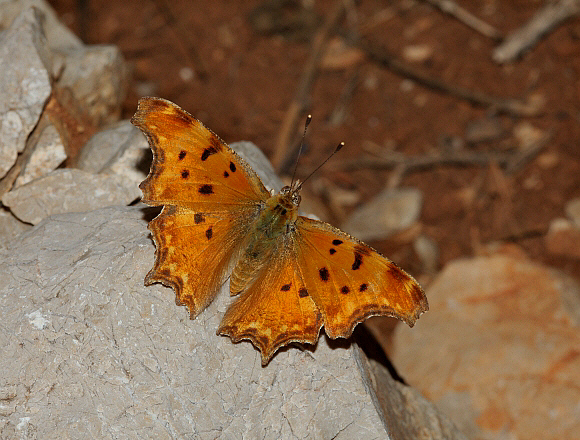 Southern Comma Polygonia egea, Croatia – Peter Bruce-Jones
Southern Comma Polygonia egea, Croatia – Peter Bruce-Jones
Introduction
The genus Polygonia comprises 14 species, found variously in North America, Europe, temperate Asia and north Africa. As a genus they are instantly recognisable by their characteristic ragged wing shape. Most share a similar upperside pattern of blackish spots on a golden-brown ground colour. On the undersides they are cryptically marked to resemble dead leaves or tree bark, and have a central white or silvery mark on the hindwing in the shape of a comma, question mark or chevron.
There are only 2 species which occur in Europe – the Comma Polygonia c-album, and the Southern Comma P. egea. The former is more heavily marked, and has a darker underside bearing a distinct comma-shaped mark.
The Southern Comma is found in south-east France, Italy, most Mediterranean islands, Croatia, Albania, Romania, Bulgaria, Greece, Turkey, and east to Syria, Iran and north-west India.
 Southern Comma Polygonia egea, Croatia – Peter Bruce-Jones
Southern Comma Polygonia egea, Croatia – Peter Bruce-Jones
Habitats
This species is found in hot, dry rocky areas including steep hillsides, gorges, archaeological ruins, and rural habitats, most commonly at altitudes between sea level and about 1000m although it has been recorded as high as 1700m in the Atlas mountains.
Lifecycle
There is some doubt as to whether this species produces 2 or 3 broods a year, and it is possible that it has a complex lifecycle like c-album, in which some larvae develop quickly while others develop very slowly, creating a staggered emergence. Most sightings of fresh adults take place in June or September-October. Adults flying in October enter into hibernation at the end of the month, and awaken in February or March of the following year.
Post-hibernation adults lay their eggs singly on the leaves of pellitory Parietaria officinalis.
The fully grown larva is blackish dorsally, with a pair of thin whitish bands between each segment, and a peppering of tiny white dots on the back. The lower half of the abdomen, the head, and the double-row of multi-branched spikes along the back, are a bright rusty-orange colour.
The chrysalis is typical of the Nymphalinae, being dull in colour but overlaid with a subtle metallic sheen. It has a double row of short spikes along the back, and a thoracic keel. It is suspended by the cremaster beneath a rock or boulder, or within the crevice of an old wall.
Adult behaviour
Males are territorial and adopt perching positions on rocks, dry paths or walls which they use as outlooks from which to survey and intercept passing females.
